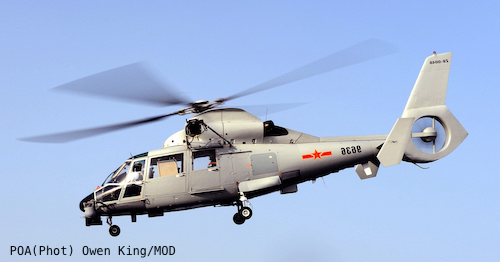Z-9 Haitun
Summary
| Category | Military Helicopters |
| Origin country | 🇨🇳 China |
| Manufacturer | Harbin |
| First flight | 1 January 1981 |
| Year introduced | 1994 |
| Number produced | 200 units |
Description
The Harbin Z-9's development began with a production patent acquired on October 15, 1980, from Aérospatiale, concerning the license-building of the French Eurocopter AS365 Dauphin in China. The initial Z-9 was assembled using components supplied by Aérospatiale, with the first flight taking place in 1981. A significant milestone was achieved on January 16, 1992, when the indigenous Z-9B variant, constructed with 70% Chinese-made parts, successfully completed its first flight. Flight testing for the Z-9B concluded in November 1992, and the design was finalized in December of the same year, leading to the commencement of production in 1993 and its subsequent entry into service with the PLA in 1994. In 2002, Harbin secured Chinese certification for the H410A variant, equipped with Turbomeca Arriel 2C turboshaft engines.
The Harbin Z-9 design is largely based on the Eurocopter AS365 Dauphin, featuring a four-blade main rotor and two turboshaft engines mounted side by side atop the cabin. Its teardrop-shaped body includes a tapered boom leading to the tail fin, a rounded nose, a stepped-up cockpit, retractable gear, and a flat bottom. A notable design modification in the Z-9B variant is the incorporation of an 11-blade Fenestron faired-in tail rotor, utilizing wider-chord, all-composite blades in place of the original AS365N's 13-blade system. Later variants have increasingly used composite materials. As a light tactical troop transport, the Z-9 has the capacity to transport 10 fully armed soldiers.
The naval Z-9C version can be fitted with an X-band KLC-1 surface search radar. Armed variants of the Z-9, such as the Z-9W, are equipped with pylons for mounting a variety of munitions, including rockets, gun pods, ET52 torpedoes, HJ-8 anti-tank missiles, or TY-90 air-to-air missiles. Some attack variants feature two fixed 23 mm Type 23-2 (AM-23) cannons. The Z-9WA, a more recent iteration with night-attack capabilities, can fire AKD10 air-to-ground missiles and is compatible with a range of anti-tank missiles like the HJ-8/9/10, light anti-ship missiles such as C-701/703 and TL-1/10 when used in an air-to-surface role, and air-to-air missiles including the TY-90 and other MANPADS for self-defense. The standard Z-9B has a payload capacity of 1,900 kg internally or 1,600 kg when slung externally.
The Harbin Z-9 has seen operational use primarily within the People's Liberation Army (PLA) across various branches, including the Air Force, Ground Air Force, and Naval Air Force. It has been deployed on Type 052D destroyers, Type 053 and 054 frigates, and Type 056 corvettes, with the Z-9C variant fulfilling SAR and ASW duties. The armed Z-9W variant has been used as a stopgap for attack capabilities. Beyond China, the Z-9 has been exported to several countries, including Pakistan, where the Z-9EC variant is utilized by the Naval Air Arm for ASW operations aboard Zulfiquar-class frigates. Other nations operating the Z-9 include Bolivia, Cambodia, Cameroon, Djibouti, Equatorial Guinea, Ghana, Kenya, Laos, Mali, Mauritania, Myanmar, Namibia, and Zambia.
Main Variants:
-
Z-9: This is the license-produced variant of the French AS.365N1, marking the initial Chinese adaptation of the Dauphin series.
-
Z-9A-100: These were prototypes developed for the domestic market, utilizing WZ8A engines as part of the indigenization effort.
-
Z-9B: Serving as a multi-role production version, the Z-9B is based on the Z-9A-100 and represents a significant step in domestic manufacturing.
-
Z-9C: This naval variant, which is license-produced from the Eurocopter AS.565 Panther, is utilized by the PLA Naval Air Force for maritime operations.
-
Z-9W: Also known as the WZ-9, this armed version features optional pylon-mounted armament, gyro stabilization, and a roof-mounted optical sight for attack missions.
Technical specifications
| Version: Z-9B | |
|---|---|
| Maximum speed | 315 km/h (196 mph) |
| Height | 3.5 m (11.4 ft) |
| Length | 13.7 m (44.9 ft) |
| Service ceiling | 6,000 m (19,685 ft) |
| Empty weight | 2,050 kg (4,519 lbs) |
| Max. takeoff weight | 4,100 kg (9,039 lbs) |
| Powerplant | 2 x turboprops Zhuzhou WZ-8A delivering 544 kW each |
Current operating countries
| Country | Units | ||
|---|---|---|---|

|
China | 316 (+11) | |

|
Cambodia | 9 | |

|
Zambia | 7 | |

|
Kenya | 6 | |

|
Bolivia | 5 | |

|
Pakistan | 5 | |

|
Ghana | 4 | |
| 🇱🇦 | Laos | 4 | |
| 🇬🇶 | Equatorial Guinea | 2 | |

|
Mauritania | 2 | |

|
Djibouti | 1 | |
All operators
Armament
Missiles payload:
- Anti-Tank HJ-8

